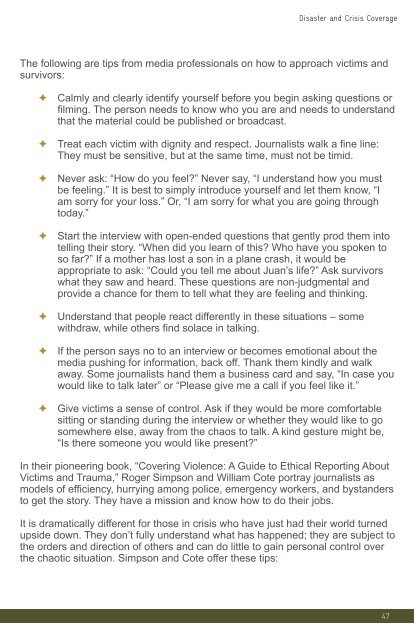Disaster and Crisis Coverage - International News Safety Institute
Disaster and Crisis Coverage - International News Safety Institute
Disaster and Crisis Coverage - International News Safety Institute
Create successful ePaper yourself
Turn your PDF publications into a flip-book with our unique Google optimized e-Paper software.
<strong>Disaster</strong> <strong>and</strong> <strong>Crisis</strong> <strong>Coverage</strong><br />
The following are tips from media professionals on how to approach victims <strong>and</strong><br />
survivors:<br />
✦<br />
✦<br />
✦<br />
✦<br />
✦<br />
✦<br />
✦<br />
Calmly <strong>and</strong> clearly identify yourself before you begin asking questions or<br />
filming. The person needs to know who you are <strong>and</strong> needs to underst<strong>and</strong><br />
that the material could be published or broadcast.<br />
Treat each victim with dignity <strong>and</strong> respect. Journalists walk a fine line:<br />
They must be sensitive, but at the same time, must not be timid.<br />
Never ask: “How do you feel?” Never say, “I underst<strong>and</strong> how you must<br />
be feeling.” It is best to simply introduce yourself <strong>and</strong> let them know, “I<br />
am sorry for your loss.” Or, “I am sorry for what you are going through<br />
today.”<br />
Start the interview with open-ended questions that gently prod them into<br />
telling their story. “When did you learn of this? Who have you spoken to<br />
so far?” If a mother has lost a son in a plane crash, it would be<br />
appropriate to ask: “Could you tell me about Juan’s life?” Ask survivors<br />
what they saw <strong>and</strong> heard. These questions are non-judgmental <strong>and</strong><br />
provide a chance for them to tell what they are feeling <strong>and</strong> thinking.<br />
Underst<strong>and</strong> that people react differently in these situations – some<br />
withdraw, while others find solace in talking.<br />
If the person says no to an interview or becomes emotional about the<br />
media pushing for information, back off. Thank them kindly <strong>and</strong> walk<br />
away. Some journalists h<strong>and</strong> them a business card <strong>and</strong> say, “In case you<br />
would like to talk later” or “Please give me a call if you feel like it.”<br />
Give victims a sense of control. Ask if they would be more comfortable<br />
sitting or st<strong>and</strong>ing during the interview or whether they would like to go<br />
somewhere else, away from the chaos to talk. A kind gesture might be,<br />
“Is there someone you would like present?”<br />
In their pioneering book, “Covering Violence: A Guide to Ethical Reporting About<br />
Victims <strong>and</strong> Trauma,” Roger Simpson <strong>and</strong> William Cote portray journalists as<br />
models of efficiency, hurrying among police, emergency workers, <strong>and</strong> byst<strong>and</strong>ers<br />
to get the story. They have a mission <strong>and</strong> know how to do their jobs.<br />
It is dramatically different for those in crisis who have just had their world turned<br />
upside down. They don’t fully underst<strong>and</strong> what has happened; they are subject to<br />
the orders <strong>and</strong> direction of others <strong>and</strong> can do little to gain personal control over<br />
the chaotic situation. Simpson <strong>and</strong> Cote offer these tips:<br />
47
















